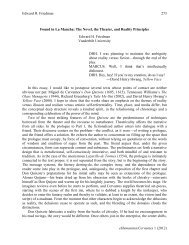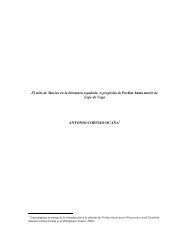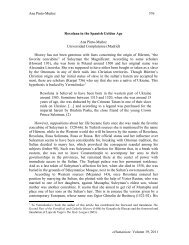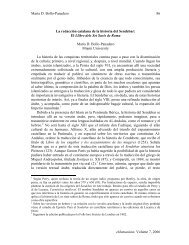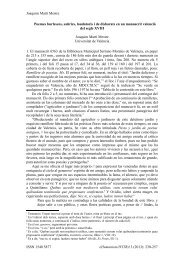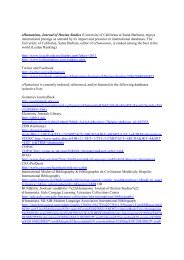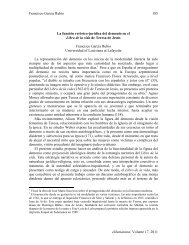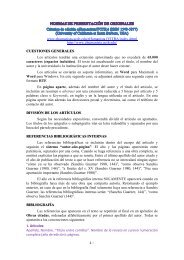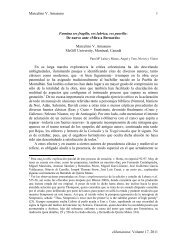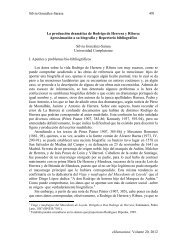Gregory Peter Andrachuk eHumanista: Volume 17, 2011 540 Alonso ...
Gregory Peter Andrachuk eHumanista: Volume 17, 2011 540 Alonso ...
Gregory Peter Andrachuk eHumanista: Volume 17, 2011 540 Alonso ...
You also want an ePaper? Increase the reach of your titles
YUMPU automatically turns print PDFs into web optimized ePapers that Google loves.
<strong>Gregory</strong> <strong>Peter</strong> <strong>Andrachuk</strong><br />
extend the investigation into the presence of the Cardona family within this text, to<br />
look at their textual connection with the character Vasquirán which represents the<br />
authorial voice, to examine pertinent aspects of their genealogy and history and<br />
finally, to make a more definitive identification of the author. The clues to the author’s<br />
identity found within the work are varied in nature, some suggestive of sound<br />
similarities while others are clues of visual description and of textual placement within<br />
the work itself. Qüestión de amor is, after all, a text which is intended to encourage the<br />
reader to decipher the embedded signals –although most readers will content<br />
themselves with the obvious. 2 While some time has elapsed since the first discovery of<br />
these clues to authorship, I remain convinced that there is a very strong likelihood that<br />
<strong>Alonso</strong> de Cardona wrote Qüestión de amor and, in fact, further research has only<br />
strengthened this conviction.<br />
The Cardona family was one of the most important and powerful Aragonese<br />
families (“un dels linatges més poderosos del regne d’Aragó” in the words of Martí de<br />
Riquer [III, 22]); they had a significant presence not only in Spain but also in the<br />
Aragonese possessions in Italy. With regard to Qüestión de amor we find one of them<br />
as a central yet background figure: Ramón Folch de Cardona, Viceroy of Naples from<br />
1508. It is the milieu of the Neapolitan court which provides the social and historical<br />
context for the entire work and while the physical appearances of the Viceroy within<br />
the text are few, they are significant. While the first part of the story takes place<br />
among the balls, hunts and jousts of the court, the focus of the second part is the battle<br />
of Ravenna between the forces of the French, led by Gaston de Foix and those of the<br />
Holy league, led by the Viceroy Ramón de Cardona. While the battle itself is not<br />
described except in the dream of Vasquirán, the preparations for this battle and its<br />
resultant devastation of the court are emphatically presented. As the battle<br />
preparations begin there is a sudden shift in the narrative from the fictitious to the<br />
2 The author distinguishes between two sets of readers –those who will interpret the text on a superficial<br />
level– “los que leyeren sin leer” and those who will read more deeply. See <strong>Andrachuk</strong> 2006, 3, n.6.<br />
Françoise Vigier does comment on one set of clues I gave –the curious clue found in the names and<br />
presence at certain points in the text of the marquises Carliner, Carlerín and Carliano, characters which<br />
I have found to be associated in the text with Vasquirán. Vigier, like Perugini (50, n.52) suggests that<br />
these are all variations on one name referring to Carlos de Aragón, Marqués de Gerace, which<br />
“répondent plutôt à des intentions ludiques”, although she provides no further explanation of how the<br />
ludic aspect of the novel might be enhanced by the use of these variants (106). It is not the identity of<br />
these three characters that is of prime concern in my interpretation; more important is what the common<br />
first syllable of the names suggests by sound to the “lecteur avisé”. There have been two other serious<br />
attributions –one to the “Vázquez” who is author of Dechado de amor (Perea Rodríguez 249: “el<br />
desconocido Vázquez”; he is possibly one Juan Vázquez de Ávila, as favoured by Vigier 445). The<br />
other attribution is to Joan Ram Escrivà de Romaní (Perugini 19). Neither of these suggestions stems<br />
from specific evidence in the work itself and therefore, in my opinion, they are less likely in view of the<br />
author’s statements regarding the encryption of identities –including his own. But if the Dechado de<br />
amor is deemed to be linked to Qüestión de amor, could “Vázquez”, like the partially homophonous<br />
“Vasquirán” be another pseudonym of the real author of Qüestion de amor, rather than the author’s real<br />
name?<br />
541<br />
<strong>eHumanista</strong>: <strong>Volume</strong> <strong>17</strong>, <strong>2011</strong>



